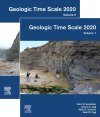By: Felix M Gradstein(Editor), James G Ogg(Editor), Mark D Schmitz(Editor), Gabi M Ogg(Editor)
1357 pages, colour photos, colour illustrations, colour maps, colour tables
![Geologic Time Scale 2020 (2-Volume Set) Geologic Time Scale 2020 (2-Volume Set)]()
Click to have a closer look
About this book
Contents
Customer reviews
Biography
Related titles
About this book
The Geologic Time Scale 2020 contains contributions from 80+ leading scientists who present syntheses in an easy-to-understand format that includes numerous colour charts, maps and photographs. In addition to detailed overviews of chronostratigraphy, evolution, geochemistry, sequence stratigraphy and planetary geology, the GTS2020 volumes have separate chapters on each geologic period with compilations of the history of divisions, the current GSSPs (global boundary stratotypes), detailed bio-geochem-sequence correlation charts, and derivation of the age models. The authors are at the forefront of chronostratigraphic research and initiatives surrounding the creation of an international geologic time scale. The included charts display the most up-to-date, international standard as ratified by the International Commission on Stratigraphy and the International Union of Geological Sciences. As the framework for deciphering the history of our planet Earth, this book is essential for practising Earth Scientists and academics.
Contents
Volume 1
PART I INTRODUCTION
1. Introduction
2. The chronostratigraphic scale
PART II CONCEPTS AND METHODS
3. Evolution and biostratigraphy (12 sub-chapters on major groups)
4. Astrochronology
5. The geomagnetic polarity time scale
6. Radioisotope geochronology
7. Strontium isotope stratigraphy
8. Osmium isotope stratigraphy
9. Sulfur isotope stratigraphy
10. Oxygen isotope stratigraphy
11. Carbon isotope stratigraphy
12. Influence of Large Igneous Provinces
13. Phanerozoic eustacy
14. Geomathematical and statistical procedures
PART III GEOLOGIC PERIODS of Planetary and Precambrian
15. The Planetary time scale
16. Precambrian (4.56 Ga to 1 Ga)
17. The Tonian and Cryogenian Period
18. The Ediacaran Period
Volume 2
PART IV GEOLOGIC PERIODS of Phanerozoic
19. The Cambrian Period
20. The Ordovician Period
21. The Silurian Period
22. The Devonian Period
23. The Carboniferous Period
24. The Permian Period
25. The Triassic Period
26. The Jurassic Period
27. The Cretaceous Period
28. The Paleogene Period
29. The Neogene Period
30. The Quaternary Period
31. The Anthropocene
Appendix 1. Color code according to the Commission for the Geological Map of the World
Appendix 2. Radioisotopic dates used in GTS2020
Customer Reviews
Biography
Felix Gradstein is a Professor Emeritus at Oslo University, Norway and a Visiting Research Fellow at the University of Portsmouth, UK. From 2000 to 2008, he was chair of the International Commission on Stratigraphy. Under his leadership major progress was made with the formal definition of chronostratigraphic units from Precambrian through Quaternary. For his fundamental work concerning the Geologic Time Scale, geochronology in general, quantitative stratigraphy and micropaleontology, the European Geosciences Union awarded him in 2010 the Jean Baptiste Lamarck Medal. He is Chair of the Geologic Time Scale Foundation and teaches courses in quantitative stratigraphy and the geologic time scale.
James Ogg (Professor at Purdue University, Indiana, USA; now retired/adjunct) is also currently a visiting distinguished professor at Chengdu University of Technology and at China University of Geoscience (Wuhan). He served as Secretary General of the International Commission on Stratigraphy (2000-2008) and currently is executive director of the Geologic TimeScale Foundation and coordinator of TimeScale Creator service. His Mesozoic Stratigraphy Lab group has worked on aspects of climate cycles, magnetic polarity correlations and integration of stratigraphic information. Their TimeScale Creator array of visualization tools and extensive databases in global and regional Earth history was used to generate many of the diagrams in this book.
Mark Schmitz is a Professor of Geochemistry at Boise State University, Idaho, USA, and has extensive research interests in the development and application of radiogenic isotope geochemistry and high-precision U-Pb geochronology to problems of Earth systems evolution. He has been an active member of the Earth Time community and was co-editor and author of The Geologic Time Scale 2012. He seeks to enrich the radioisotopic calibration of the time scale through targeted dating of stratigraphically important volcanic event beds and the construction of robust chronostratigraphic models through geologic time. His extensive database with over 300 standardized radiogenic isotope ages (mainly U/Pb and Ar/Ar) is vital to this book.
Gabi Ogg applied micropaleontology to Jurassic-Cretaceous correlations before concentrating on public outreach in geosciences. She coordinated the extensive array of graphics in this book and is the webmaster for the Geologic TimeScale Foundation and for the TimeScale Creator visualization and database suites. In addition to co-authoring A Concise Geologic Time Scale (GTS2016) and The Geologic Time Scale (GTS2012) books, she has produced numerous posters and time scale cards for public audiences.
By: Felix M Gradstein(Editor), James G Ogg(Editor), Mark D Schmitz(Editor), Gabi M Ogg(Editor)
1357 pages, colour photos, colour illustrations, colour maps, colour tables


































